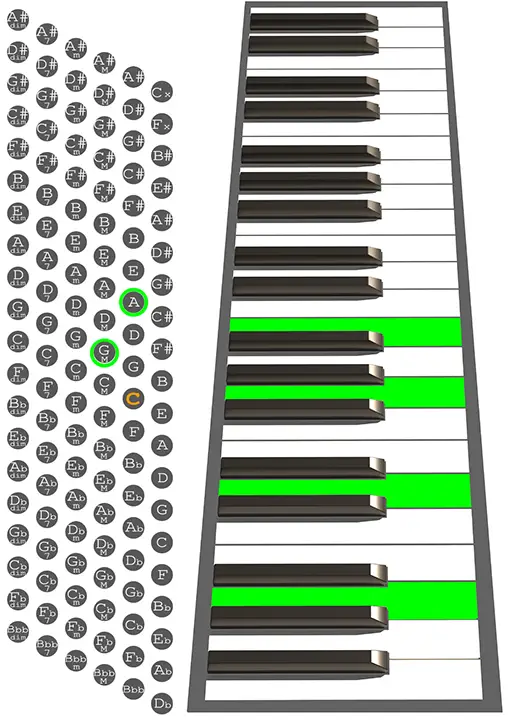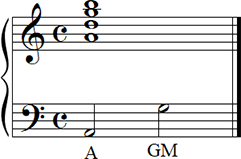AKA: A9 sus4, A ninth suspended fourth, A9sus, A nine suspended, A Dominant ninth suspended 4
A9sus4 Chord on Accordion

9sus4 Chords
These chords can add a sense of tension and resolution to a musical phrase and are often used to create movement and interest in a chord progression. Sus4 chords are chords that are built by replacing the 3rd note of the scale with the 4th note. A 9sus4 chord is a type of suspended chord that is built by adding the 7th and the 9th note of the scale to a sus4 chord.
For example, in the key of C, a Csus4 chord would consist of the notes C, F, and G, with the F replacing the E that would be in a standard C major chord. A 9sus4 chord would add the Bb (7th) and the D (9th) to the Csus4 chord, resulting in the notes C, F, G, Bb, and D, which are root, perfect 4th, perfect 5th, minor 7th and major 9th intervals.
A9sus4: In-depth analysis
For a more in-depth grasp of the A9sus4 chord, delve into my article titled “A9sus4 Piano Chord – Charts, Harmony, and Music Theory” on ChordsAround.com
9sus4 Chords on Accordion
On a standard bass accordion, 9sus4 chords are actually 9sus4(5omit) because no button combination allows for the creation of a complete 9sus4 chord that includes the 5th (which btw doesn’t add any tension to the chord). This chord is the best option available on the Stradella system to play a suspended chord.
A 9sus4(5omit) chord can be created by combining a root note with the Major chord built on its minor 7th interval.
For example, combining the root note C with the Bb Major chord (since Bb is at a minor 7th interval from C) results in a C9sus4(5omit) chord, which is formed by the notes C, F, Bb, and D (root, perfect 4th, minor 7th, and 9th). To simplify the nomenclature, we avoid mentioning the missing 5th every time we mention this chord, just remember it.
It’s very similar to a ninth eleventh chord but it does not have either the 3rd or the 5th and the 11th is seen as a 4th.

Notes:
A, D, G, B
Intervals:
R, 4°, m7°, 9°
Left hand:
A + GM
Fingering:
2 + 4
or
3 + 5
Giovanni
I have a question about the fingering numbers that you use. Do you use the continental finger numbers , or the American finger numbers? I think you use the continental finger numbers. The Hanon fingering exercise that you suggested I use turned out to be American fingering on the bass, but not a problem on the treble notes.
Hi Stephen,
I’m sorry but I’m not sure I know what you are referring to.
As I know the Hanon use the piano fingering system so you have the same numbers on both hands from thumb (1) to pinky (5).
The Hanon for accordion has even the fingering for chromatic accordions but basses should be numbered from 2 up to 5 as usual.
I should see a page of your Hanon to give you a better reply.
Hi Giovanni,
Thanks to accordionchords.com, I’ve been able to put together a little ready reference table to help me locate, use and learn each m7 and each m9 chord. Due to them coming up quite often in scores, I’m now looking for similar in a sus4 chord. I note you only include a 9sus4 and, having learned how thorough you are, suspect that may be the only usable option. Am I right, or is there an alternative possibility?
Thanks for all you do to support accordionists forum with accordionchords.
Hi Rodney,
I’m glad to hear that accordionchords.com has been helpful for you! Regarding your question about sus4 chords on the Stradella bass system, you are correct that there isn’t a specific button combination that sounds as a sus4 chord like there is for m7 and m9 chords.
However, you can still play a sus4 chord by using a combination of bass and keyboard notes. One common approach is to use a combination of the root in the bass, along with notes that form the sus4 chord in the right hand. Experimenting with different combinations can help you achieve the desired sound.
Thank you for your kind words, and I’m here to help if you have any further questions or need assistance.
Giovanni